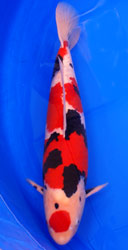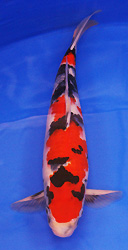| The 38th All Japan Combined Nishikigoi Show |
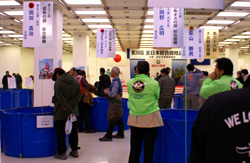 The All Japan Combined Nishikigoi Show, which marked its 38th year, was held in Tokyo on January 20 and 21, 2007. The All Japan Combined Nishikigoi Show, which marked its 38th year, was held in Tokyo on January 20 and 21, 2007.
This show is the largest of its kind in Japan, the birth land of Nishikigoi, and might be well called the world show. Koi lovers from Southeast Asian countries, the United States, Europe and other countries from around the world exhibited their valuable Koi at this show to vie in their beauty.
This year, Koi lovers from Indonesia and Singapore won the Jumbo Koi and Big Koi Division champions, respectively, and this show became in reality and in name the “world show.” I would like to express my sincere congratulations to Mr. Katsuo Shibayama who won the Grand Champion, in other words "the world champion," with his outstandingly beautiful Showa Sanshoku.
We are announcing the results of the awards. The nine overall champions are posted with pictures and commentaries
Taro Kodama, Vice Chairman of INPC
|
Dates: January 20 (Sat) and 21 (Sun) 2007
Hosted by: All Japan Nishikigoi Promotion Association
Sponsors: Ministry of Agriculture, Forestry and Fisheries, Tokyo Metropolitan Government, Niigata Prefecture |
 The
38th Show Grand Champion The
38th Show Grand Champion |
| Variety classification / Division |
Showa
Sanshoku / 85th Division |
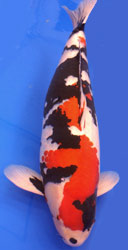 |
| Award winners (Prefecture) |
Katsuo Shibayama (Saitama) |
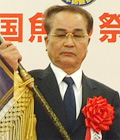 |
| Katsuo Shibayama |
[Commentary]
No other word than “beautiful” can describe this Koi. I have not seen many Showa Sanshoku astonishing as this one.
The finish of the hi, clear sumi, and gloss of the skin: each of these characteristics is superior to that of other Koi. The overall patterns are not necessarily perfect, but “the patterns on the head,” “the beautiful odome,” and “the contrast of the hi and sumi depicted on the beautiful shiroji” are what captivate the people.
Even if a perfect hi pattern does not exist, the appearance of sumi has made the hi pattern become beautiful. Furthermore, “sumi” “beni” and “shiroji” are of the highest quality.
This Showa Sanshoku was born at Dainichi Koi Farm, a Nishikigoi breeder representing Japan, located in Niigata. A Koi produced at Dainichi Koi Farm, one of INPC’s supporters, proudly won the Grand Champion in the “world’s” Koi show.
|
|
 Gigantic Koi Division Overall Champion Gigantic Koi Division Overall Champion |
| Variety classification / Division |
Kohaku / 90th Division |
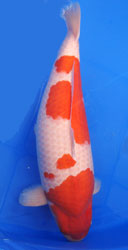 |
| Award winner (Country) |
Richard Tan (Singapore) |
 |
| Richard Tan |
[Commentary]
The appeal of this Koi is the big, sumo wrestler like body conformation. What first catches the eye is the “dynamic yet graceful swim” that this body produces. The head and body are wide, the tail covert is also well fleshed, and this excellent body conformation has the figure of a log; this Koi is a good example of why Koi are called the “King of ornamental fish.”
The patterns are not a simple nidan (two step). The two patches between the first and second hi plates are well balanced and make this Koi very unique.
There may be Koi lovers who dislike red eyes in a Koi, but this Koi's body conformation and patterns are qualities that cover such faults.
Just imaging the elegant swim of a Koi with this kind of body conformation gives one thrills, which is one of biggest reasons this Koi became champion of the Gigantic Koi Division.
|
|
 Jumbo Koi Division Overall Champion Jumbo Koi Division Overall Champion |
| Variety classification / Division |
Showa
Sanshoku / 80th Division |
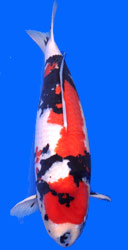 |
| Award winner (Country) |
N Budiono Gunawan (Indonesia) |
 |
| N Budiono Gunawan |
[Commentary]
The appeal of this Showa is in its unique beauty. The fine head pattern, the distinct and dynamic hi pattern running straight from the head to the tail, and the sumi that unites such patterns are what create the beauty of this Koi.
The kata zumi (sumi on the shoulders) makes this Koi especially more beautiful.
The kata zumi intertwining with the ichidan and nidan hi patterns create a menware (a sumi pattern seen only in Showa or Shiro Utsuri that divides the head) leading to the formation of an exquisite shiroji pattern. A Koi possessing such distinctive beauty certainly deserves to be the Jumbo Koi champion.
|
|
 Jumbo Male Koi Division Overall Champion Jumbo Male Koi Division Overall Champion |
| Variety classification / Division |
Showa
Sanshoku Utsurimono / 90th Division |
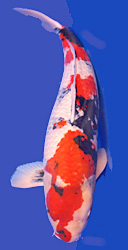 |
| Award winner (Prefecture) |
Tadashi Koguchi (Ibaraki) |
 |
|
Tadashi Koguchi
|
[Commentary]
This powerful Showa Sanshoku Koi has dynamic patterns on a long-stretching body.
Compared to Kohaku and Taisho Sanshoku, Showa Sanshoku is a variety that does not grow, but this Koi grew to be almost 90cm (36 inches). One can see the splendor of the Isa Showa bloodline. A slightly fuller, more lustered body would have been even better.
|
|
 Mature Koi Division Overall Champion Mature Koi Division Overall Champion |
| Variety classification / Division |
Utsurimono
/ 65th Division |
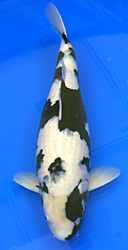 |
| Award winner (Country) |
Razif Abdullah (Malaysia) |
 |
|
Razif Abdullah
|
[Commentary]
This is a beautiful Shiro Utsuri that certainly deserves to win a prize.
The shiroji on the shoulders is fascinating, and the back part of the body is depicted with a mixture of pure white skin and deep black sumi. This is what brings out the beauty of a Shiro Utsuri.
If the kata zumi becomes more refined, it will bring out even more the shiroji of this Koi. This is a Koi with great potential.
|
|
|
|
 Adult Koi Division Overall Champion Adult Koi Division Overall Champion |
| Variety classification / Division |
Kohaku / 55th Division |
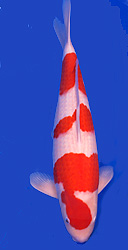 |
| Award winner (Prefecture) |
Shinji Okada (Hyogo) |
 |
|
Shinji Okada
|
[Commentary]
This is a high-quality Koi with a lot of potentials.
The high-quality skin and excellent beni quality are nicely balanced and create a well-distributed pattern. This Kohaku is ideal with “good body, good quality, and good patterns.”
This Koi has hidden potentials and will become excellent depending on how it is raised. It will become a captivating Koi.
|
|
|
|
 Baby Koi Division Overall Champion Baby Koi Division Overall Champion |
| Variety classification / Division |
Kohaku
/ 20th Division |
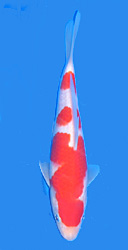 |
| Award winner (Prefecture) |
Tadashi
Koguchi (Ibaraki) |
 |
|
Tadashi Koguchi
|
[Commentary]
This is a Sandan Kohaku with good head patterns and odome.
At a glance, one may think that the ichidan hi pattern is quite large, but the shiroji that cuts in on the left and right of the ichidan creates a nice balance. This Koi will show more shiroji when it grows, so it has a promising future.
|
|
| *Award winners are the owners of the award winning Koi. |
The exhibited Koi are categorized into divisions based on their body length. Each division, beginning from the 15th up to the 90th, consists of 5 sub-divisions. The numbers represent the Koi’s length (in centimeters).
For example, the 15th division includes Koi of length up to 15cm (6 inches), the 30th division from 25 to 30cm (from 10 to 12 inches), the 80th division from 75 to 80cm (from 30 to 32 inches), and the 90th division of over 85cm (34 inches). Koi over 50cm (20 inches, Koi in the 55th division and above) are categorized into the General division and Male Koi division. They are divided into the following varieties |
|
General Division
- Kohaku
- Taisho Sanke
- Showa Sanshoku
- Utsurimono
- Hikari Muji
- Hikari Moyo
- Asagi
- Shusui
- Goshiki
- Kawari variety
- A Ginrin (Gosanke)
- B Ginrin (other than A Ginrin)
- Bekko
- Hikari Utsuri
- Tancho
- Koromo
- Doitsu Koi
(not including Shusui, Hikarimono, and Kumonryu)
- Kujaku (including Doitsu Kujaku)
- Kumonryu
A total of 19 varieties as listed above
|
Male Koi Division
- Kohaku
- Taisho Sanke
- A Ginrin (Gosanke)
- Showa Sanshoku, Utsurimono
- Hikarimono (only Hikarimono)
- Doitsu Koi
(not including Shusui, Hikarimono)
- Kawari Koi
(those other than the mentioned 6 varieties)
A total of 7 varieties as listed above
|
All exhibited Koi are considered for ballot from all judges. The following awards are given out.
- The 38th Show Overall Champion
(selected by all judges among all exhibited Koi)
- Champion (1 Koi for every 360 category), and a considerable number of Runners-up
- First Runners-up
(a considerable number of high-grade Koi of each division selected from the Runners-up)
- Kokugyo Prize
(the best Koi among the award winning Koi (based on variety) of each division. a total of 33 Koi)
- Division Overall Champions
(selected from each division’s Kokugyo Prize winning Koi for the following)
Baby Koi Division (up to 25cm (10inches)) Overall Champion
Young Koi Division (over 25 to 40cm (10 to 16inches)) Overall
Champion
Adulte Koi Division (over 40 to 55cm (16 to 22 inches))Overall
Champion
Matur Koi Division (over 55 to 70cm (22 to 28 inches)) Overall
Champion
Jumbo Koi Division (over 70 to 80cm (28 to 32 inches)) Overall
Champion
Gigantic Koi Division (over 80 to 90cm (32 to 36 inches)) Overall Champion
Matur Male Koi Division Overall Champion
Jumbo Male Koi Division Overall Champion
|
 The All Japan Combined Nishikigoi Show, which marked its 38th year, was held in Tokyo on January 20 and 21, 2007.
The All Japan Combined Nishikigoi Show, which marked its 38th year, was held in Tokyo on January 20 and 21, 2007.










